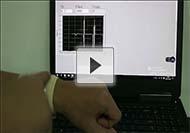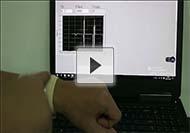
Credit: American Chemical Society
Electronic textiles could allow a person to control household appliances or computers from a distance simply by touching a wristband or other item of clothing — something that could be particularly helpful for those with limited mobility. Now researchers, reporting in ACS Nano, have developed a new type of e-textile that is self-powered, highly sensitive and washable. A video of an e-wristband in action is available here.
E-textiles are not new, but most existing versions have poor air permeability, can't be laundered or are too costly or complex to mass-produce. Jiaona Wang, Hengyu Guo, Congju Li and coworkers wanted to develop an E-textile that overcomes all of these limitations and is highly sensitive to human touch.
The researchers made a self-powered triboelectric nanogenerator by depositing an electrode array of conductive carbon nanotubes on nylon fabric. To make the E-textile washable, they incorporated polyurethane into the carbon nanotube ink, which made the nanotubes firmly adhere to the fabric. They covered the array with a piece of silk and fashioned the textile into a wristband. When swiped with a finger in different patterns, the E-textile generated electrical signals that were coupled to computers to control programs, or to household objects to turn on lights, a fan or a microwave from across the room. The E-textile is breathable for human skin, washable and inexpensive to produce on a large scale, the researchers say.
###
The authors acknowledge funding from the Beijing Natural Science Foundation, the National Natural Science Foundation, National Key R&D Project from Minister of Science and Technology, the Programs for Beijing Science and Technology Leading Talent, the Beijing Hundred, Thousand and Ten Thousand Talent Project, the General Program of Science and Technology Development Project of Beijing Municipal Education Commission of China, Beijing Institute of Fashion Technology and the "Thousands Talents" Program for Pioneer Researcher and His Innovation Team.
The abstract that accompanies this study is available here.
The American Chemical Society, the world's largest scientific society, is a not-for-profit organization chartered by the U.S. Congress. ACS is a global leader in providing access to chemistry-related information and research through its multiple databases, peer-reviewed journals and scientific conferences. ACS does not conduct research, but published and publicizes peer-reviewed scientific studies. Its main offices are in Washington, D.C., and Columbus, Ohio.
To automatically receive news releases from the American Chemical Society, contact [email protected].
Follow us on Twitter | Facebook
Media Contact
Katie Cottingham
[email protected]
301-775-8455
@ACSpressroom
http://www.acs.org





